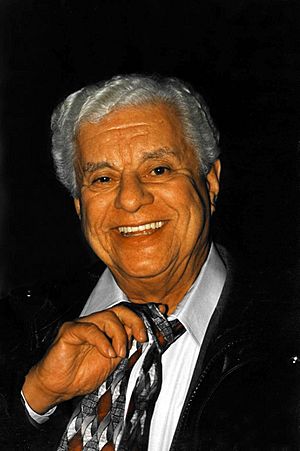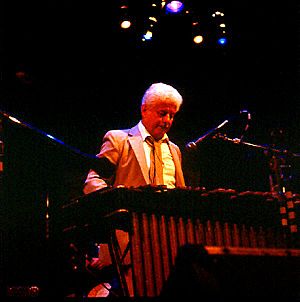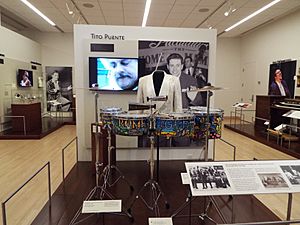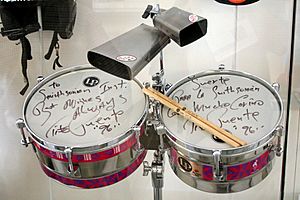Tito Puente facts for kids
Quick facts for kids
Tito Puente
|
|
|---|---|

Puente in 1996
|
|
| Background information | |
| Birth name | Ernest Anthony Puente Jr. |
| Born | April 20, 1923 New York City, U.S. |
| Died | June 1, 2000 (aged 77) New York City, U.S. |
| Genres |
|
| Occupation(s) |
|
| Instruments |
|
| Years active | 1946–2000 |
| Labels |
|
| Associated acts |
|
| Military Service | |
| Allegiance | |
| Service/ |
|
| Years of service | 1942-1946 |
| Rank | Bugler First Class |
| Unit | USS Santee (CVE-29) |
| Battles/wars | World War II,Operation Torch, Guadalcanal Campaign, New Guinea Campaign, Asiatic-Pacific Theater, Battle of Philippine Sea, Battle of Guam, Luzon Campaign, Iwo Jima Operation, Okinawa Gunto Operation |
| Awards |
|
Ernest Anthony Puente Jr. (born April 20, 1923 – died June 1, 2000), known as Tito Puente, was an American musician. He was also a songwriter, bandleader, and record producer. His family came from Puerto Rico.
Tito Puente was famous for his exciting mambo and Latin jazz songs. He had a career that lasted 50 years. His most well-known song is "Oye Como Va".
Puente and his music appeared in movies like The Mambo Kings. He was also a guest on TV shows such as Sesame Street and The Simpsons.
Contents
Early Life and Music Beginnings
Tito Puente was born on April 20, 1923, in New York City. His parents were from Puerto Rico and lived in Spanish Harlem. As a child, Tito was very energetic.
When he was seven, his neighbors complained about him banging on pots and window frames. So, his mother sent him to piano lessons. By age 10, he switched to playing percussion instruments. He was inspired by jazz drummer Gene Krupa.
In the 1930s, Tito and his sister Anna formed a song-and-dance duo. He wanted to be a dancer, but an ankle injury stopped him. Later, he joined Machito's band as a drummer.
Music Career and Success
Tito Puente served in the Navy for three years during World War II. He was drafted in 1942. He fought in nine battles on the ship USS Santee (CVE-29). After the war, he used the GI Bill to study music at Juilliard School of Music. He learned about conducting, arranging music, and music theory.
In the 1950s, Puente became very popular. He helped bring Afro-Cuban and Caribbean music to many people. This included styles like mambo, son, and cha-cha-chá. His album Dance Mania came out in 1958. It is one of his most famous works.
One of his most famous songs is "Oye como va" from 1963. Latin rock musician Carlos Santana made it even more popular. Other artists like Julio Iglesias and Celia Cruz also performed it.
In 2000, Puente appeared in the music movie Calle 54. His name is also often mentioned in a film called La Epoca. This film is about the Palladium era in New York. It talks about Afro-Cuban music, mambo, and salsa dancing.
Family and Legacy
Tito Puente's son, Richard "Richie" Puente, was a percussionist in the 1970s band Foxy. His youngest son, Tito Puente Jr., continues his father's musical legacy. He performs and records many of his father's songs. Tito's daughter, Audrey Puente, is a TV weather reporter in New York City.
After a show in Puerto Rico on May 31, 2000, Tito Puente had a serious heart attack. He was flown to New York City for surgery. But he had problems after the surgery and died on June 1, 2000. In 2003, he was given the Grammy Lifetime Achievement Award after his death.
Awards and Special Recognition
Tito Puente received many awards and honors for his music:
- In 1995, he received the Billboard Latin Music Lifetime Achievement Award.
- The Senate of Puerto Rico held a special session for him. He was allowed to perform his music there.
- On September 10, 2007, a United States Post Office in Spanish Harlem was named after him.
- An amphitheater in San Juan, Puerto Rico, was named in his honor.
- In 1995, he received an honorary music degree from Berklee College of Music.
- Puente performed at the closing ceremonies of the 1996 Summer Olympics in Atlanta. The timbales he used are now in a museum in Washington, D.C.
- In 1997, he received the National Medal of Arts.
- In 1990, he received a Star on the Hollywood Walk Of Fame.
- On June 5, 2005, he was honored with a star on the Walk of Fame in Union City, New Jersey.
- In 1999, he was added to the International Latin Music Hall of Fame.
- On May 19, 1999, he received another honorary music degree from Columbia University.
- On August 20, 2000, East 110th Street in Spanish Harlem was renamed 'Tito Puente Way'.
- On October 11, 2022, Google Doodle honored Puente for Hispanic Heritage Month.
Tito Puente on The Simpsons
Tito Puente appeared in a two-part episode of The Simpsons in 1995. The episodes were called "Who Shot Mr. Burns?". In the story, Puente becomes a music teacher at Springfield Elementary School.
However, Mr. Burns takes the oil from under the school. This causes the school to lose money and cut its music program. So, Puente loses his job. When Mr. Burns is later shot, Puente is a suspect. But he proves his innocence by playing one of his songs for Chief Wiggum.
The song "Señor Burns" from the episode was nominated for an Emmy Award. It is featured on the 1999 album Go Simpsonic with The Simpsons.
Images for kids
See also
 In Spanish: Tito Puente para niños
In Spanish: Tito Puente para niños







